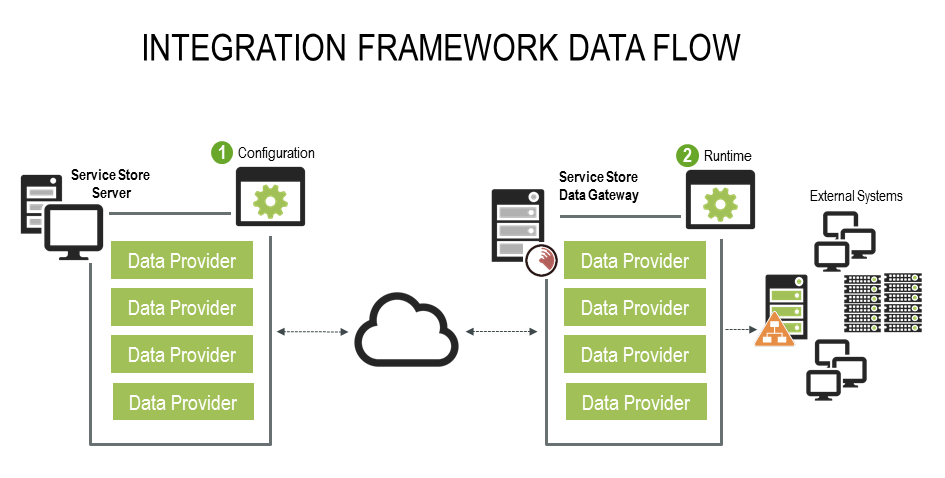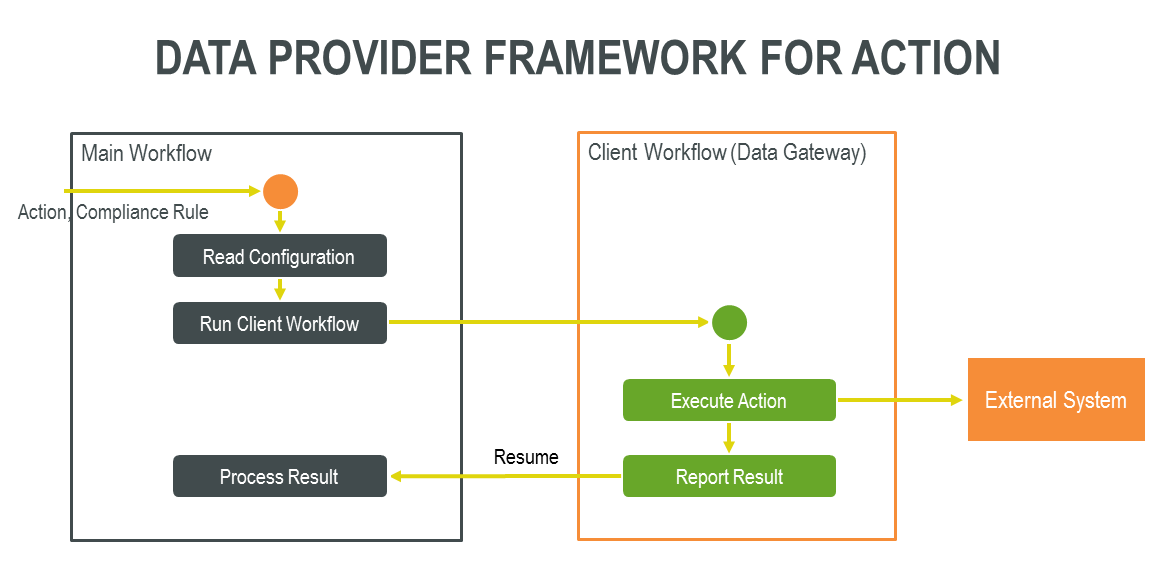Integration Framework and Data Providers
Overview
Matrix42 Enterprise Service Management Platform provides a set of tools and components for integration with any external system. It could be anything from ERP and CRM systems to CSV files on file share or endpoint devices for which the hardware and software inventory should be made.
There are two main scenarios for integration:
- Batch Import – loading data from an external system. For example, the system can load users from Active Directory, get network configuration from VMware, synchronize mobile devices from Matrix42 Mobile Device Management.
- Perform Action – executing specific operations in an external system or synchronizing data to an external system. For example, the system can lock/unlock an account in Active Directory, rename a computer in Active Directory after it has been renamed in Matrix42 Enterprise Service Management Platform, provision mobile devices in Matrix42 Mobile Device Management.
Integration logic is encapsulated in Data Providers. A dedicated Data Provider must be configured to integrate each external system. The Data Provider configuration provides such data as the connection string and credentials necessary to log on to a specific system and data that governs the communication process between Matrix42 Enterprise Service Management Platform and the external system.
Data Providers are executed by Data Gateways that enable the communication and data exchange between systems. By default the Data Gateway is installed on the Matrix42 Enterprise Service Management Platform server. However, it can also be installed on any computer or multiple computers inside a corporate network or data center in case Matrix42 Enterprise Service Management Platform does not have direct access to the external system.
The Data Gateway communicates with Matrix42 Enterprise Service Management Platform using REST over HTTPS, which means that all communications are secure and no special firewall rules or VPNs are required.
Integration Framework
Matrix42 Enterprise Service Management Platform provides a framework that allows creating a new Data Provider by using workflows and without any coding.
Both bulk loading of data from an external system and execution of actions that are designed in Matrix42 Enterprise Service Management Platform externally can be implemented by using workflows. In both cases, the process of data exchange is represented by six simple steps.
Bulk Loading
1 - Triggering the Data Provider
A separate Data Provider should be configured for each external system. Triggering the Data Provider starts the data exchange process. It can be triggered either manually by a user or automatically by an engine activation.
2 - Running the Server Workflow
The Data Provider runs a specific server workflow that is designed for importing records from an external system into Matrix42 Enterprise Service Management Platform. For example, the AD workflow is used for importing Active Directory objects into Matrix42 Enterprise Service Management Platform.
3 - Running the Client Workflow
The server workflow uses integration settings from the Data Provider object to access the Data Gateway that is installed on the intranet or in an external corporate network. It is often the case that Matrix42 Enterprise Service Management Platform has no access to the corporate network for security reasons. However, the Data Gateway can be installed in the network and exchange data with Matrix42 Enterprise Service Management Platform. The Data Gateway communicates with the server workflow. When it is triggered by the server workflow, it runs the client workflow in the corporate network. For example, the AD workflow on the server starts the AD - Client workflow in a corporate network.
4 - Collecting Data
The client workflow collects data from the corporate network or data center. For example, it can collect data pertaining to Active Directory accounts, data center infrastructure, hardware and software specifics of the computers in the network, etc.
5 - Passing the Collected Data to the Server Workflow
When the client workflow instance is successfully completed, the obtained data is passed to the server workflow. The data can be passed from one workflow to another by using a package of XML files. In such a case, the client workflow creates a package of XML files and then the Matrix42 Enterprise Service Management Platform server workflow receives these files.
To prevent performance issues during large data imports, the Collect Data Package size is limited to 2 GB. If the package exceeds this limit, split the data into partitions by using separate Data Provider configurations.
6 - Processing the Collected Data
The server workflow processes the collected data and saves it to Matrix42 Enterprise Service Management Platform. For example, it can use import definitions to match the values that are retrieved from an external system and corresponding fields of a Matrix42 Enterprise Service Management Platform object.

Executing Actions Externally
By using a Data Gateway, a number of actions can be executed in a corporate network. For example, a password can be reset for an Active Directory account or Matrix42 Enterprise Service Management Platform computers can be synchronized to an AD server.
1 - Triggering the Data Provider or a Compliance Rule
Triggering the Data Provider starts the data exchange process. It can be triggered either manually by a user or automatically by an engine activation. Compliance rules can also be used for starting the synchronization process. When conditions specified in a compliance rule for a certain configuration item are fulfilled, the compliance rule is triggered.
2 - Running the Server Workflow
The Data Provider or the compliance rule starts a server workflow. The workflow collects the object data that should be transferred to an external system. For example, the Create AD Account workflow retrieves all account records that meet the conditions of a corresponding compliance rule.
3 - Running the Client Workflow
Based on the Data Provider settings, the server workflow accesses the Data Gateway which is installed on the intranet or in an external corporate network. When triggered, the Data Gateway runs a client workflow. For example, the Create AD Account on Agent workflow receives the object data from the Create AD Account server workflow and matches it with the objects on an AD server. Then the AD objects are either added or updated correspondingly.
4 - Executing an Action Externally
The client workflow executes a certain action in a corporate network. It can be resetting password for an Active Directory account or updating attributes of other AD objects based on changes made to these objects in Matrix42 Enterprise Service Management Platform.
5, 6 - Returning Results to Server Workflow
When the client workflow completes the required action, it can send the successful result to the server workflow. In case of synchronization to an Active Directory server, the AD server workflow saves the SID attribute values for each object that has been synchronized to an AD server.
Follow the links below to learn about:


